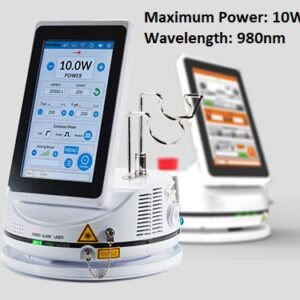Laser Therapy for Low Back Disc Degeneration
Degenerative disc disease in the lumbar spine, or lower back, refers to a syndrome in which age-related wear and tear on a spinal disc causes low back pain.
In other words, Degenerative disk disease is when normal changes that take place in the disks of your spine cause pain.
Speaking of the causes of this issue, the spinal disks are made up of a soft inner core and a tough outer wall. The disks change in ways that may cause degenerative disk disease, such as:
- Drying out: When you’re born, the disks in your spine are mostly made up of water. As you age, they lose water and get thinner. Flatter disks can’t absorb shocks as well. The water loss also means less cushion or padding between your vertebrae. This can lead to other problems in your spine that may cause pain.
- Crack: The stress of everyday movements and minor injuries over the years can cause tiny tears in the outer wall, which contains nerves. Any tears near the nerves can become painful.
Moving on to symptoms, patients should probably feel a sharp or constant pain in their back and neck. But, the exact symptom often depends on where the weak disk is and other changes it has caused.
Common signs include pain that:
- Is in lower back, buttocks, or upper thighs
- Come and go. It can be nagging or severe and can last from a few days to a few months.
- Feels worse when you sit, and better when you move and walk
- Feels worse when you bend, lift, or twist
- Gets better when you change positions or lie down
Low Back Disc Degeneration causes quite severe pain. That is why quick treatment seems to be a necessity. Laser therapy can be used in the treatment of such kinds of back pain since virtually any kind of back pain can be effectively treated by using laser treatment.
It is of importance to note, however, that the quality of the laser machine used for treatment has been a determining factor that strongly impacted the recovery quality and duration.
Relatedly, the Physiotherapy Diode Laser System. SIFLASER-1.41 has been recurrently used by a number of specialists as it proved its high efficacy in treating such an issue.
Indeed, this Laser therapy machine has a wide range of clinical applications, including painful low back issues such as Low Back Disc Degeneration.
Unlike many pharmacological treatments that mask pain or only address the symptoms of disease, Laser Therapy treats the underlying condition or pathology to promote healing. This means that the treatments are effective and the benefits of Laser Therapy are long-lasting.
To explain in more detail, The device is targeted haemoglobin and cytochrome c oxidase. So, in sharp contrast to “Cold lasers” which provide no feeling or sensation, high power diode laser therapy will provide a warm and soothing feeling which is the exact thing requested from low back disc pain patients.
Low Back Pain is a very annoying, painful and life-crippling issue. Treatment is a must, especially for those cases who suffer severe pain. Luckily, Laser therapy has been developed to provide pain management services. As such, patients with Low Back Disc Degeneration can get reassured and less sensitive to pain as long as SIFLASER-1.41 is specifically designed to provide them with a pain-free treatment that will effectively restore their physical function and life comfort.
Reference: Lumbar Degenerative Disc Disease (DDD)
Disclaimer: Although the information we provide is used by different doctors and medical staff to perform their procedures and clinical applications, the information contained in this article is for consideration only. SIFSOF is not responsible neither for the misuse of the device nor for the wrong or random generalizability of the device in all clinical applications or procedures mentioned in our articles. Users must have the proper training and skills to perform the procedure with each Laser system.
The products mentioned in this article are only for sale to medical staff (doctors, nurses, certified practitioners, etc.) or to private users assisted by or under the supervision of a medical professional.

